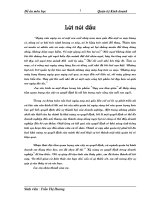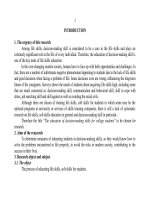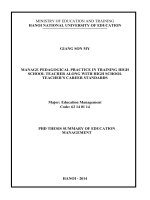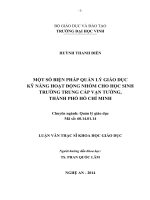giáo dục kỹ năng ra quyết định cho sinh viên đại học bản tóm tắt tiếng anh
Bạn đang xem bản rút gọn của tài liệu. Xem và tải ngay bản đầy đủ của tài liệu tại đây (284.28 KB, 30 trang )
INTRODUCTION
1. The urgency of this research
Among life skills, decision-making skill is considered to be a core in the life skills and plays an
extremely significant role in the life of every individual. Therefore, the education of decision-making skill is
one of the key tasks of life skills education.
In the ever-changing modern society, human have to face up with both opportunities and challenges. In
fact, there are a number of unfortunate negative phenomenon happening to students due to the lack of life skills
and good decisions when facing a problem of life. Some decisions even are wrong, influencing the long-term
future of the youngsters. Surveys shows the needs of students about acquiring life skills high, including some
that are much concerned as: decision-making skill, communication and behavioral skill, skill to cope with
stress, job searching skill and skill against as well as avoiding the social evils.
Although there are classes of training life skills, soft skills for students in which some may be the
optional programs at university or services of skills training companies, there is still a lack of systematic
research on life skills, soft skills education in general and decision-making skill in particular .
Therefore the title “The education of decision-making skills for college students” to be chosen for
research.
2. Aims of the reasearch
To determine measures of educating students in decision-making skills, so they would know how to
solve the problems encountered in life properly, to avoid the risks in modern society, contributing to the
success in their lives.
3. Research object and subject
3.1. The object
The process of educating life skills, soft skills for students.
1
3.2. The subject
Relation between methods and results of educating decision-making skill for students.
4. Hypothesis
When making decisions, students nowadays are still sentimental, thus, they would easily encounter
risks or failures in life. If decision-making skills education were systematic, in which it is ensured the basic
steps of decision-making and organization skills for students to apply in solving primary problems in school
and daily life with various educational measures, students would improve their ability of making appropriate
and effective decisions.
5. Research tasks
5.1. Building a theoretical basis of decision-making skills education for students.
5.2. Investigating and evaluating the actual state of decision-making skills education for students in some
universities.
5.3. Recommending measures to educate decision-making skills for students. Designing the content and
organizing the experiments of decision-making skills education experiments for students through practical
research activities.
6. Research Methodology
6.1 Group of theoretical research methods
We use those methods of analysis, synthesis, comparison, generalization, modeling concepts, the
factors that constitute the basis of of theorical education in decision making skills for students.
6.2 Group of practical research methods
6.2.1 Investigation method (in anket)
We use the anket investigating form to collect information on the status of decision making skills and
educating this skill for students.
6.2.2 Method of in-depth interviews
2
We use in-depth interview method to interview a number of students, lecturers and administrators to
find out the status of decision making skills of students, and educating this skill for students and the causes
of those situations.
6.2.3 Observation method
We observe the activities of students to learn the change in their attitude, behavior during the process
of building up decision making skills to verify and supplement the information obtained from the survey,
interviews and experimental process.
6.2.4 Studying typical-case method
Studying typical-case method help us to clarify the positive changes in selecting and making
appropriate decisions to solve the problems encountered in life after participating in the experiment.
6.2.5 Experimental method
We use this method to evaluate the feasibility and effectiveness of the measures using to educatie
decision making skills for students, contributing to scientific hypothesis testing
6.2.6 Working product method
Regards to the process of making decision in groups of students in the experiment situations to
evaluate decision making skills of students and through the log we note out the application of decision
making skills in situations that students encounter in life (Activities followed Experiments).
6.3 Groups of complementary methods
6.3.1 Method of processing data obtained by statistics and SPSS software
This method is used to process the data collected from situation and expremental investigation to draw
the necessary conclusions.
6.3.2 Expert method
Using this method to refer the opinion of some experts in developing the research outline, choosing
research methods, setting survey questionnaire and assessing decision making skills
3
7. Research scope
- Decision making skills is mainly examined under the aspect of socio-psycological ability.
- Investigating the decision making skills of students in six universities: Hue University, Vinh
University, Hong Duc University, University of Construction, Foreign Trade University, Hanoi University of
Education and organizing the experiments in Hong Duc University.
- Experiment form of educating decision-making skills for students is club activity.
- Number of researchers: 679 students, 120 lecturers
- Time of survey: March 2010
- Experimental time: August, 2010 to December, 2011
8. The contribution of thesis
8.1. In theory
The thesis contributes and develops the theories on decision-making skills education for students in
the context of higher education in Vietnam.
8.2. In practice
The research results reflect the state decision-making skills and decision-making skills education for
students today. On that basis, we introduce the measure of education associated with solving common
problems in student life in order to help them make appropriate decisions, avoiding risks and contributing to
the improvement of adaptive capacity in modern society.
9. The discussing arguments
- Decision-making skill is one of the core life skills directly associated with problem solving skills. If
individuals had the proper decision-making skills, they would be able to solve problems effectively, because
decision-making skills has oriented meaning, and solving the problem is the implementation stage.
- It is possible for us to form, train and develop decision-making skill to students by equipping the basic
4
steps of decision-making skills, then we organize students to apply this skill into identify target , manage time,
solve conflict, cope with the social evils
- Educating and training decision-making skills at the same time require and promote related life skills
such as critical thinking, creative thinking, value determining, goal defining… Therefore, decision-making
skill education must be adhered to other life skills education as a whole.
Chapter 1
THEOTICAL BASIS OF EDUCATING DECISION MAKING SKILL TO STUDENTS
1.1. Historical overview of the research issue
1.1.1. The external researches
The authors mentioned the decision making in different types of decisions, identifying the steps of decision
making process, the factors interfering with the decision-making as well as making effective decision, methods of
making important decisions and be responsible to their decisions.
Apart from researches on decision-making skill of all subjects in daily life, there are also some studies
on decision-making skill in time management, learning planning, eating and drinking leading to success in
sport, military or avoiding risks in complex enviroment .
From management perspective, the studies mentioned decision-making as the key issue in
management; discussing the process of decision making and decision-making stages , the matters of selecting
decision in manufacturing management Researches on the field of management psychology refer to those
elements such as: preparing decisions, conditions to ensure the effectiveness of decisions, influences on the
leaders’ prestige on their decisions, the obstacles on the way of implementing, testing and evaluating
The studies of decision-making skill in the field of business mentioned the whole process of effective
5
decision-making, from the beginning to the final stage, the definition and classification of decisions, content
of identifying the decision-making styles; the ways to get to a decision; choosing decision-making
participants; collecting information; predicting the future.
1.1.2. The domestic researches
Decision-making skill education for learners is mentioned in the studies for pupils or disadvantaged
children of Nguyen Thanh Binh, Luu Thu Thuy, Nguyen Thi Oanh… In Vietnam, decision-making skills
have also been considered in different fields as management science, management psychology, military,
business.
In summary, throught studying both external and domestic researches, it is obvious that there are
studies on decision-making skills as a life skills or management skills, but there is no research on educating
decision-making skill for students. Therefore, studying decision-making skill education to solve problems in
the lives of students today is indeed a new and essential issue.
1.2. Relevant tool concepts
1.2.1. Skill
There have been a great number of researches on skills which set up different concepts and the author
of this thesis accords with Vu Dung’ attitude, it is said that: "Skill is the ability of effectively manipulating
knowledge about acting procedure which has been perceived by the subject to perform the corresponding
task".
1.2.2. Life skill
The concept of life skills is very diverse, the understanding of life skills associated with specific
cultures and contexts. In this topic the author chose the concept: Life skill as the socio-psychological
capacity which helps people adapt, communicate, solve situations in modern social in a positive and
effective way.
1.2.3. Decision-making skills
6
Making decision means: The achieving of optimal alternative from a number of alternatives to solve
the problems, situations in life.
Decision-making skill is: The ability of people to chose the optimal alternatives from the possible
options to promptly and effectively solve problems in life. The efficiency needs to be associated with
contribution and appropriate to contexts.
1.2.4. Decision-making skill education
Educating decision-making skills is an deliberate and organized influence process with relevant
content, methods and measures of educational forces in order to build up and develope decision-making
skills for educated people.
1.3. The process of educating decision-making skills for student
1.3.1. The necessity of educating decision-making skills for students
1.3.1.1. Social request
It’s necessary that people in contemporary society should be equipped with life skills in general and
decision-making in particular so that they can make appropriate decisions to succeed and enhance their living
standard.
1.3.1.2. The socio-psychological characteristics of students
Students are those who are physically grown up at the stage in which nervous system has developed
stably and strength, agility, great endurance, flexibility, toughness thrive.
In addition, students possess exceptional creativity, dynamics and enthusiasm in social activities. If
they are well oriented and have good decision-making skill, they will certainly be the key contributors to
national science and technology and a fair society.
As a matter of fact, studying is really time-consming but has an important role in student life. Students
should not only acquire former and current technology advances but also show their creativeness in studies
and career activities. Students like to participate social activities, group activities, communication, new
7
things and love to explore, create, they are also sensitive to life, but if they don’t get good orientation, it will
have bad affects on their ideals for living.
1.3.2. Goals of student decision-making skills education
Help students understand the meaning and method of decision making skill implementation also the
decision-making stages and the meaning of the decision-making skills, know how to apply decision-making
skills in dealing with situations in daily life. Therefore, they can build up positive and healthy behaviors or
habits which are appropriate with the true values of society, at the same time eliminating the immature
decision making habbits which lead to risks in everyday life, forming and training other complementary life
skills related to decision-making skills.
1.3.3. Content of educating decision making for students
1.3.3.1 Prepare process of implementing decision making skill
There are five steps of decision making: detemining the problem, collecting necessary information,
listing possible solutions, analyzing them and choosing the optimum one.
1.3.3.2 Decision-making skill education in association with students' problems
- Apply decision-making skill to solving study problems
- Apply decision-making skill to time management
- Apply decision-making skill to problems in daily life
1.3.4. Principles of Decision-making skill education for students
Decision making skill education for students should conform with principles: experiencing through
activities, interaction and behavior change.
1.3.5. Methods of Decision-making skill educationfor students
Methods of Decision-making skill educationfor students consist of brainstorming, discussion, practice,
case study, studying typical examples and games and acting.
1.3.6. Methods of Decision-making skill education for students at university
8
Decision-making skill education for students is implemented by some methods: Through studying
subjects in curriculum. through teaching optional subjects or special subjects on living skills or soft skills,
through extra-curricular activities, through corresponding, through real situations.
1.3.7. Process of organizing to teach decision-making skill for students
- First, organizing for students to experience decision-making skill
- Second, organizing and putting students into various situations (maybe assumptions)
- Third, requiring students to go on applying decision-making skill in specific situations to consolidate
and develop this skill.
- Forth, evaluating students' results of establishing decision-making skill.
1.3.8. Assessment about the level of students' decision-making skill
1.3.8.1. Determining criteria
Analyzing the nature and steps of decision-making skill can determine criteria:
- Comprehend and apply the five-step process of decision-making
- Analyze, recognize and determine problems of the situations
- Create and list possible solutions to solve the problems
- Be aware of and analyze advantages and disadvantages of each solution
- Choose the optimum solution
1.3.8.2. Assessment method
Evaluating decision-making. should be a combination of methods (method of observation,
investigation through questionnaires for lecturers and students and especially, method of observation and
product research)
1.3.9. Teaching staff of decision-making skill for students
Managing board deligates responsibilities to student mission department, lecturers, form teachers,
study consultants, Youth Union and Student Union so as to carry out decision making skill education for
9
students
1.4. Factors influencing decision-making education for students
1.4.1. Objective factors: residence environment, living standards, examples or public figures, class environment,
campus, families and student social group. Especially, friends have significant impacts on students' decision-making.
1.4.2. Subjective factors: goals, value, lifestyle, health, decisiveness, awareness of practice, ability of
awareness, especially critical thinking and creative thinking to make a guess, responsibility, ability to take
responsibility together with other living skills… Actually, these factors directly affect the teaching of
decision-making skill for students and quality of their decisions.
Chapter 2
SITUATION OF DECISION MAKING SKILLS EDUCATION TO STUDENTS IN UNIVERSITIES
NOWADAYS
2.1. Survey aims and methods
2.1.1. Survey aims
Studying situation of decision-making of students and decision-making education for them at some
universities is to specify the practice and on that basis we would suggest more effective methods in educating
the skill for students.
2.1.2. Survey methods
The methods include Questionnaire, method of in-depth interviews (to managers, lecturers and
students), observing students’ decision-making, studying typical-case method.
2.2. Analysis of research results about the real situation of some issues on decision-making skill and
10
Decision-making skill education for students
2.2.1. Awareness of managers, lecturers and students about the significance of teaching decision-making
skill for students
The statics results in table 2.1a (thesis) indicate that the majority of managers and lectures ( 94%) and
students (97%) are aware of the significance of decision-making skill education for students. Also, our
interviews find out some opinions on significance of decision-making skill education for students. Many
lecturers and students suppose that it's important for everyone to attempt prompt and appropriate decisions in
their lives and those who have decision-making skill can make a lot of great success . In contrast, lack of
decision-making skill may cause wrong decisions which have bad effects on individual living standards and
the society. Therefore, decision-making skill education for the youth in general and students in particular is
undeniably of great importance.
2.2.2 Opinions of managers, lecturers and students about decision-making skill
Table 2.2: Opinions of managers, lecturers and students about decision-making skill
No Answers
Managers and
lecturers
Students
Quantity % Quantity %
1 Ability to find out solutions to problems and situations
in daily life 13 10.83 72 10.33
2 Ability to choose the most advantageous answer for
problems and situations
9 7.50 99 14.20
11
3 Ability to choose the optimum answer among possible
answers to tackle problems in daily life promptly and
effectively
60 50.00 264 37.88
4 Ability to choose an answer appropriate for problems
and situations
9 7.50 163 23.39
5 Ability to choose the optimum answer to tackle
problems in daily life
28 23.34 81 11.62
6 No answer 1 0.83 18 2.58
Total 120 100.00 697 100.00
Among five answer, answer No. 3 is the most appropriate one. Acording to the results in the above
table, only 50% managers and lecturers and 37.88% students choose the correct answer. This indicates that
the majority of students are not fully aware of decision-making skill conception.
2.2.3. Awareness of managers, lecturers and students about the significance of decision-making skill for
personal life
12
Table 2.3: Awareness of managers, lecturers and students about the significance of decision-making skill
for individuals.
No Significances
Managers and
lecturers
Students
Quantity % Quantity %
1 For individual successes in life
65 54.17 372 53.37
2 For individuals' independence and master of their lives 83 69.17 480 68.87
3 For individuals' self-confidence 44 36.67 288 41.32
4 For effective working solutions 77 64.17 448 64.28
5 For effective solutions to situations in daily life
53 44.17 319 45.77
6 For individuals' healthy life and good behavior
17 14.17 182 26.11
7 For individuals' good communication and good behavior
in daily life
42 35.00 289 41.46
8 For risk avoidance 28 23.33 150 21.52
9 For avoiding socail evils 22 18.33 185 26.54
The results in table 2.3 show that awareness of managers, lecturers and students about the
significances of decision-making skill comprise those for individuals independence and master of life,
13
effective solutions to problems and situations in daily life, sucesses in life, self-confidence… This also
indicates that students are in great need of living skills in general and decision-making skill in particular.
Managers and lecturers haven't fully evaluate the role of decision-making skill in every field of student life.
2.3. The real situation of decision-making skill of students
2.3.1. The real situation of students' difficulties in making decisions
14
Table 2.4a: Students' difficulties in making decisions
No Issues
Managers and lecturers Students
Quantity % Quantity %
1 In studies
44 36.67 113 16.21
2 In behavior
69 57.50 369 52.94
3 In sentimental relationship and sex
60 50,00 297 42.61
4 In avoiding social evils 41 34.17 64 9.18
5 In dealing with stress 48 40.00 204 29.27
6 In time management 61 50.83 213 30.56
7 In determining relevant goals 47 39.17 233 33.43
8 In determining value 14 11.67 121 17.36
9 In future career activities 40 33.33 189 27.12
According to the figures in the above table, it's clear that there are a great number of difficulties facing
students in decision-making such as in behavior, sentimental relationship and sex, time management,
determining relevant goals. Studies Actually, these are issues that students often encounter in their daily
life. And students find their most difficulties making decisions in their relationship, behavior, sentimental
relationship and time management (30-50%)
2.3.2. Students’ attitude when making decisions in daily life
Results in table 2.5b (in thesis) shows that over 66% of students usually prepare possible solutions to
15
daily problems (26.11% often and 40.03% quite often). A small number of students ignore the problems
(over 3.59% often and 5.02% quite often). Therefore, most students are aware of dealing with daily problems
because they prepare possible solutions in an active way. In fact, over 50% of students rarely or never put
aside situations, 0.28% of them sometimes make late decisions and 0.43% make prompt decisions quite
often.
2.3.3. The real situation of students' decision-making way
According to results in table 2.5b (thesis), two most chosen ways by students are considering
thoroughly to find out the best solution ( over 80% students choose often and quite often) and analyzing the
problems to choose the suitable solution (nearly 90% students choose often and quite often). A lot of students
also select the way of making decisions according to personal experience (about 80% students choose often and
quite often). The results show that students are quite cautious about making a decision on a certain issue.
However, they are still not aware of analyzing and choosing suitable solutions. In actual fact, a lot of students
don't take problems into consideration before making decisions but make up their mind according to their
experience or interests.
2.3.4. The steps of students' decision-making
Research results in table 2.7b (thesis) show that students consider their decision-making process to be
quite good. All steps are chosen by students often and quite often with a high percentage (over 50%). Some
steps are selected by students often and quite often with high percentages such as determining problems
(over 86%), choosing the optimum solution (over 80%) and listing possible solutions (approximately 70%).
Hence, the majority of students carried out and conformed to all steps. This is a chance for them
to make good decisions. If we had used method of observing and researching products to assess, the
results would have been definitely worse.
With a view to supplementing the above results and checking whether students make decisions
following the steps in the correct way or not, we put forward question 10b (Appendix 1, thesis) and question
16
11b (Appendix 2, thesis). The results in table 2.7c (thesis) indicate that up to 78.9% of students have
disordered decision-making skill. Our interviews show that most of students make decisions according to
their subjective, interests and feelings without conforming to a certain process. That's why there is no
certainty about whether their decisions are relevant or not.
2.3.5 Students' demands for being taught about decision-making skill
2.3.5.1 Level of students’ demands for being taught about decision-making skill
Table 2.8 (thesis) indicates that students have high demands for being taught about decision making skill (over 88%
of students want and really want). Students are in urgent need of decision making skill because they are well aware of its
significance. Percentage of students who do not want to be taught this skill is very small. And this situation should be taken
into consideration by universities.
2.3.5.2 Issues of students’ demands for being taught about decision-making skill
The figures in 2.9 (thesis) show that students' opinion on their demand for decision-making skill
education are nearly similar to those of managers and lecturers but students have a higher percentage of
opinions on the demand than mangers and lecturers. Students' demand for being taught about decision-
making skill is the highest in the field of daily life (71.59%) accompanied by teaching decision-making
together with other supplementary skills (70.01%), in future career activities (67.29%) and in studies
(61.69%). Future career activities and studies are difficult issues to students.
In reality, students are still confused about making decisions on many fields of life. This would be because
there are so many challenges and changes in social life but students are lack of life experience and don't easily
adapt to these changes. And due to their lack of financial aids and low living standards, a great number of students
encounter difficulties in making their own living to pay tuition fees.
2.4. The real situation of decision-making skill education for students at university
2.4.1. Assessments of managers, lecturers and students about the level of Decision-making skill education
for students
17
Table 2.10: Assessments of managers, lecturers and students about the level of decision-making skill
education for students
No Answers
Managers and lecturers Students
Quantity % Quantity %
1 No answer 1 0.83 6 0.86
2 Not educated 4 3.33 50 7.17
3 Rarely 11 9.17 84 12.05
4 Sometimes 37 30.83 317 45.48
5 Quite often 54 45.00 139 19.94
6 Often 13 10.83 101 14.49
The results in table 2.10 indicate that students have lower appreciation towards the level of being
taught about decision-making than managers and lecturers do. Only 30% students feel that they are taught
decision-making skill often and quite often. Nearly 20% students reckon that they rarely or not taught about
decision-making skill. These are undeniably worth taking notice of. Actually, our assessments are mainly
based on students' opinions because they can experience whether they are educated the skill or not. The
reason for the difference in level of students' being taught about decision-making skill would be that they
take further courses in skill training centers or part in voluntary activities of clubs at university.
2.4.2. Forms of educating decision-making skill for students
Studying the issue we have found out the results in table 2.11(thesis)
Research results from the above table indicate that 60% managers and lecturers and 53.8% students
reckon that students are taught about decision-making skill by dealing with real situations. It is actually the
most chosen form by managers, lecturers and students. This is absolutely true because students get decision-
making skill through their practices and experience. Throug real information, some universities such as Foreign
18
Trade University, Hanoi National University of Education, Hue University have classes of living skills/ soft
skills for students. Another form should be teaching decision-making skill through classes of living skills and
soft skills, which is highly appreciated and approved by managers and lecturers (30% mangers and lecturers
and 23.1% students).
Teaching the skill through reality, countryside, sightseeing, contests, consulting member and club
activities are many other organizing forms which are underestimated by managers, lecturers and students.
This clearly proves that the above organizing forms at university are of little use or even no use.
2.4.3. Results of educating decision-making skill for students
Table 2.12: Results of courses in organizing forms of decision-making skill education for students
No Effectiveness
Managers and
lecturers
Students
Quantity % Quantity %
1 Understand the significance of decision-making skill
in daily life
68 56.67 407 58.39
2 Know necessary steps to make best decisions
26 21.67 168 24.10
3 Apply decision-making steps to situations in daily life
33 27.50 193 27.69
4 Other
The statistics in table 2.12 show that opinions of managers and lecturers are quite consistent with
those of students in terms of effectiveness of decision-making skill education for students. In fact,
stusdents don't get much comprehension after taking part in classes for living skills. 58.39% of students
are aware of the significance of decision making skill education. The percentage of students who are
aware of the significance is double those who know steps in decision making (24.10%) and only
27.69% apply the steps to situations in daily life
19
2.4.4. Teaching staff for decision-making education for students
Results in table 2.13 (thesis) show that the most highly appreciated groups are Youth Union and
Student Union (67.50% managers and lecturers and 55.81% students choose) followed by form teachers,
study consultants, student mission department (over 65% managers and lecturers choose) though they are not
highly appreciated by students (over 30%). Managing board is not highly appreciated by students (13.49%).
From practical observation, we've learned that these people are core forces in teaching living skills and
decision-making skill for students.
2.4.5. Assessment about degree of satisfaction towards the process of Decision-making skill education for
students
From the figures in table 2.14 (thesis) together with finding out reasons, we've learned that there is a
limitation on experience, decision-making and finance and students' time and interests, which has bad effects
on the effectiveness of organizing and thus, the degree of satisfaction and great satisfaction are not high
enough.
2.5. Factors influencing students' decision-making skill
Figures in table 2.15 (thesis) show that objective factors such as environmental and social effects,
parents' desire and family background are highly appreciated by managers, lecturers and students. Moreover,
subjective factors individual experience, analytic and prediction ability also have great impacts on students.
2.6. The real situation of difficulties in educating decision-making skill for students
Our research results in table 2.16 (thesis) indicate that students always long to practice decision-
making skill as well as soft skills but universities still not pay enough attention to the issue. That's why
students are looking for soft skill training centers to study. Difficulties such as lack of time and financial aids
are also recognized by a great number of students (40%). A small number of students consider their
ignorance as a difficulty (18.94%).
20
Chapter 3
METHODS OF EDUCATING DECISION MAKING SKILL FOR STUDENTS
3.1. Principles of educating decision-making skill for students
Apart from basing on theory and reality mentioned in chapter 1 and 2, it’s necessary to conform with below
principles to educate decision making skill for students: Ensure complex access to other teaching methods;
ensure that teaching methods are suitable for students' needs, expectations and character; ensure decision-
making skill education through practices and applying the skill to situations in daily life; ensure the principle of
getting access to activities and joining with students
3.2. Decision-making skill education for students
Teaching methods of decision making skill for students consist of educating the skill through a
combination of subjects, compulsory and optional subjects, special subjects for life skills and soft skills,
corresponding member and extra curricular activities such as practices, sightseeing and clubs.
3.3. Conditions for ensuring the effectiveness of Decision-making skill education for students
The conditions consist of guidance, lecturers, students, time, facilities and finance.
3.4. Experimental teaching
3.4.1. Experimental subjects
We have carried out an experiment in decision-making skill education for students K12 (58 students in
Experimental research group and 60 in Control experiment group) and students K13 (39 students in
Experimental research group and 40 in Control experiment group) at Faculty of Psychology -Education in
Hong Duc University.
21
3.4.2. Experimental content
The experiment is carried out in the forms of club activities about decision making in
determining relevant goals, studies, time management, behavior, sentimental relationship and
avoiding social evils.
3.4.3.Criteria and assessment scale
We evaluate the level of students’ decision making skill according to the following criteria:
* Awareness:
We require students to understand and analyse the nature of decision making skill, list all decision
making steps in the right order, roles and significance of the skill in daily life and know well about contents
of decision making skill in behavior, avoiding social evils, sentimental relationship, determing relevant goals
and time management.
* Attitude
Students should be enthusiastic about taking courses in decision making skill to apply to their daily
life, supporting the right and fighting against the wrong.
* Behavior
In order to assess students’ decision making skill, we base on signs of decision making skill such as
suitability, flexibility and effectiveness and use different methods like observation and investigating through
questionnaires and interviews.
The author also used this tool to evaluate students’ decision making skill for each topic by combining
method of observation with product research to figure out how frequent students carry out steps above in 5
situations of each topic.
- Asessment scale
22
In terms of awareness, we have tests with mark 5
In terms of behavior, we use five-level form for mark 5
The assement is based on total mark of awareness, attitude and behavior
3.4.4. Results of influence experiment
The results are illustrated as follows
Graph 3.1: Results of
Experiemental research group’s
awareness before and after the
first influence
Graph 3.2: Results of Control
experiment group’s awareness
before and after the first influence
23
Graph 3.3: Results of
Experiemental research group’s
attitude before and after the first
influence
Graph 3.4: Results of Control
experiement group’s attitude
before and after the first influence
Graph 3.5: Results of Experiemental
research group’s behavior before
and after the first influence
Graph 3.6: Results of Control
experiement group’s behavior
before and after the first influence
24
Graph 3.7: Results of
Experiemental research group’s
awareness before and after the
second influence
Graph 3.8: Results of Control
experiment group’s awareness
before and after the second
influence
Graph
3.9: Results of Experiemental research
Graph
3.10: Results of Control experiement
25









